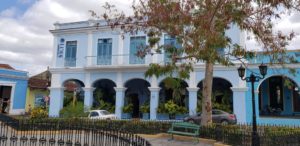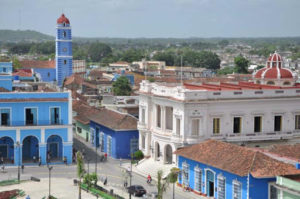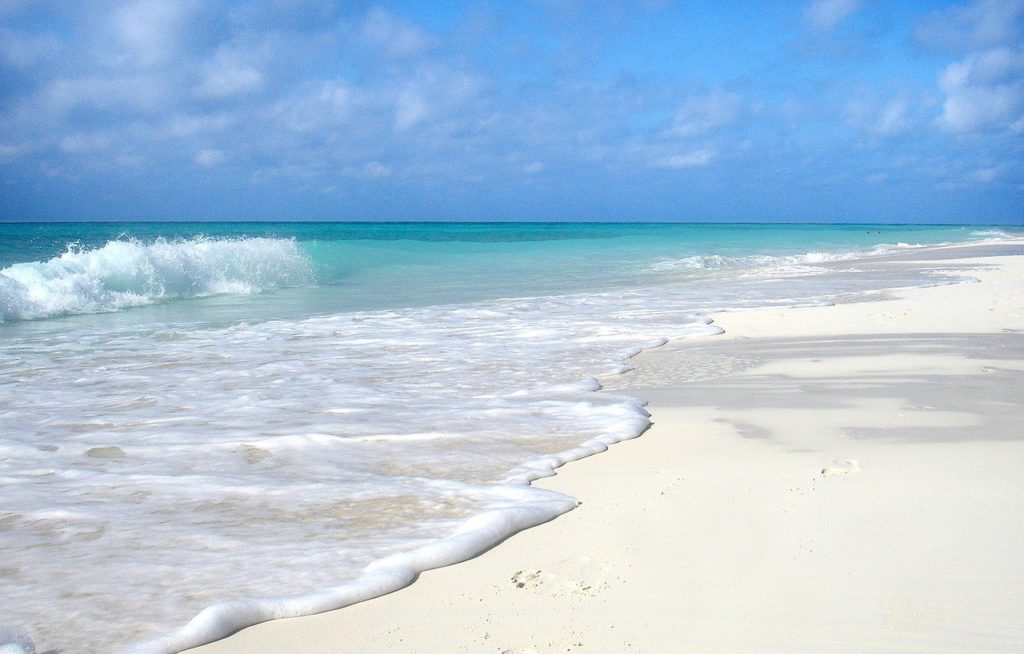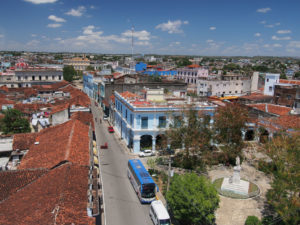 VIAJE A LO LARGO DE CUBA: SANCTI SPIRITUS, “LA CIUDAD DEL YAYABO”. VIDEOS.
VIAJE A LO LARGO DE CUBA: SANCTI SPIRITUS, “LA CIUDAD DEL YAYABO”. VIDEOS.
Según los cronistas, Sancti Spiritus tiene sus orígenes fundacionales en tierras de gigantescas arboledas, de abundantes cedros y ceibas, en una llanura fértil y en la zona aborigen de Magón, nombre que los nativos daban a la región donde se levantara la villa a orillas de los rios Tuinucú y a la vera de Yayabo, sus dos corrientes fluviales que vieron hace 506 años a la cuarta villa fundada por España en su camino de conquista.
Fue exactamente el 4 de junio de 1514 cuando nace la villa del Espíritu Santo (Sancti Spíritus), fundada por el Adelantado Don Diego Velázquez y cuyo centro histórico urbano es uno de los conjuntos arquitectónicos más notables del país, conformado por edificaciones de los siglos XVII al XX.
En la zona colonial confluyen las distintas épocas constructivas a partir del barroco español, regional o criollo y el neoclásico.
En 1522, los españoles la trasladaron para el lugar definitivo, en las márgenes del río Yayabo, a unos ocho kilómetros del lugar original.
En sus primeras construcciones predominaron el guano y la tabla, provocando continuos y considerables incendios que motivaron, por el año 1786, la primera regulación urbanística, que prohibía ese tipo de fabricación en el centro de la ciudad.
Sin embargo, progresivamente, las edificaciones se levantaron a base y ladrillo embarrado y tejas.
De estrechas y complicadas calles, resalta una arquitectura colonial salpicada a ratos por la modernidad.
La bonanza económica llega a Sancti Spíritus en el siglo XIX, cuando crece la demanda nacional por su ganado, al punto de completar en un solo envío hacia La Habana hasta 20 mil cabezas.
Nacen entonces las obras arquitectónicas que, junto a la Iglesia Parroquial Mayor, concluida en 1680, distinguen hoy a la ciudad por todo el mundo: el teatro Principal y el puente sobre el río Yayabo.
La música espirituana se extendió por toda la región central cubana, personificada en el plano campesino con el llamado punto espirituano, el más antiguo de Cuba, caracterizado por el estribillo establecido dentro del punto guajiro, el más relacionado y parecido al son.
Su coro de claves es genuino, afinado y conservador. Las Parrandas Espirituanas, las congas y comparsas son la expresión de un rico aporte a los géneros musicales puramente cubanos.
La urbe posee hoy un espacio –en la calle Honorato– que recuerda, con cinco grandes campanas, la historia recorrida desde aquel 4 de junio de 1514 hasta 2014, fecha en que Sancti Spíritus cumplió 500 años.
En la calle que conduce a la Iglesia Parroquial Mayor (Monumento Nacional), así como también a otros sitios del centro histórico urbano, se erigen estas obras que realzan el entorno. Cada una de ellas recoge 100 años; la primera abarca de 1514 a 1614, y así sucesivamente hasta completar los cinco siglos de vida de esta ciudad, a unos 350 kilómetros al este de La Habana.
Ahora, con seis años más sobre sus hombros, pueden admirarse estas campanas, que semejan el color del bronce y donde sobresale en el frente el escudo de la ciudad donde aparecen una paloma con las alas extendidas, cuatro banderas cubanas, las letras N y S y el lema Mi lealtad acrisolada; en el borde inferior la frase: Testigo del Tiempo.
Este lema hace referencia a la fidelidad mantenida por el Ayuntamiento a España, cuando en 1762 los ingleses tomaron La Habana, mientras que la paloma representa el Espíritu Santo.
Conocida como la Ciudad del Yayabo por el nombre del río que la atraviesa; o por la Ciudad de los Murales, lo cierto es que Sancti Spíritus se reafirma como joya patrimonial, orgullosa de sus habitantes.
 JOURNEY ALONG CUBA: SANCTI SPIRITUS, “THE CITY OF YAYABO”. VIDEOS.
JOURNEY ALONG CUBA: SANCTI SPIRITUS, “THE CITY OF YAYABO”. VIDEOS.
According to the chroniclers, Sancti Spiritus has its founding origins in lands of gigantic groves, abundant cedars and kapok trees, in a fertile plain and in the Aboriginal area of Magón, a name that the natives gave to the region where the town was built on the shores of the Tuinucú rivers and near Yayabo, its two river currents that saw 506 years ago the fourth town founded by Spain on its path of conquest.
It was exactly on June 4, 1514, when the town of the Holy Spirit (Sancti Spíritus) was born, founded by the Adelantado Don Diego Velázquez and whose urban historical center is one of the most notable architectural ensembles in the country, made up of buildings from the 17th centuries to XX.
In the colonial zone, the different constructive periods come together from the Spanish, regional, or Creole baroque and the neoclassical.
In 1522, the Spanish moved it to the final place, on the banks of the Yayabo River, about eight kilometers from the original place.
In its first constructions, guano and tabla predominated, causing continuous and considerable fires that motivated, by the year 1786, the first urban regulation, which prohibited this type of manufacturing in the city center.
However, progressively, the buildings were built with base and mud brick and tiles.
With narrow and complicated streets, it highlights a colonial architecture dotted at times with modernity.
The economic boom reached Sancti Spíritus in the 19th century, when the national demand for its livestock grew, to the point of completing up to 20 thousand heads in a single shipment to Havana.
Then the architectural works are born that, together with the Greater Parish Church, completed in 1680, today distinguish the city from all over the world: the Principal theater and the bridge over the Yayabo River.
Spiritus music spread throughout the central Cuban region, personified at the peasant level with the so-called Espirituano point, the oldest in Cuba, characterized by the chorus established within the Guajiro point, the most related and similar to son.
Its chorus of keys is genuine, in tune, and conservative. Las Parrandas Espirituanas, congas, and comparsas are the expressions of a rich contribution to purely Cuban musical genres.
Today the city has space –on Honorato Street– that recalls, with five great bells, the history traveled from that June 4, 1514, to 2014, the date on which Sancti Spíritus turned 500 years old.
In the street that leads to the Iglesia Parroquial Mayor (National Monument), as well as to other sites in the urban historical center, these works are erected that enhance the environment. Each of them collects 100 years; the first covers from 1514 to 1614, and so on until completing the five centuries of the life of this city, about 350 kilometers east of Havana.
Now, with six more years on his shoulders, these bells can be admired, which resemble the color of bronze and where the coat of arms of the city stands out in the front where a dove appears with wings spread, four Cuban flags, the letters N and S and the motto My loyalty acrisolada; at the bottom edge the phrase: Witness to Time.
This motto refers to the fidelity maintained by the City Council to Spain, when in 1762 the English took Havana, while the dove represents the Holy Spirit.
Known as the City of Yayabo by the name of the river that runs through it; or by the City of Murals, the truth is that Sancti Spíritus reaffirms itself as a heritage jewel, proud of its inhabitants.
Agencies/ RHC/ Guadalupe Yaujar/ Maite González/ Internet Photos/ Arnoldo Varona/ www.TheCubanHistory.com
THE CUBAN HISTORY, HOLLYWOOD.









